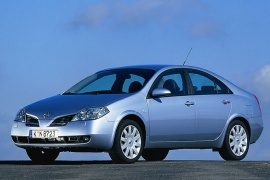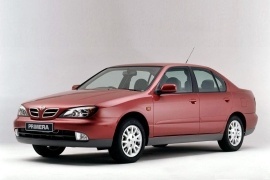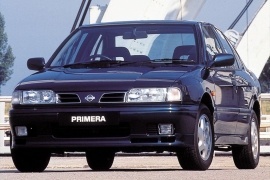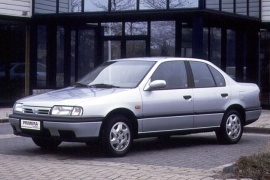
NISSAN Primera Sedan
Generations Timeline, Specs and Pictures

Unveiled at the 2001 Barcelona Motor Show, the Nissan Primera had a distinctive design compared to the previous models.
While the Nissan Primera was already a good car, it was also boring, bringing nothing more than a good drive. However, things changed starting with 2001, and the new sedan became interesting and almost pretty.
While it retained some of the second generation’s styling cues, such as the wing-styled front grille, although larger.
Inside, the Nissan Primera offered great space for its occupants. The unconventional interior design draw attention and drivers might have needed a little time to adjust.
All the main instruments and controls were placed in the center, including the cluster gauges. The way the controls were arranged gave the impression of a flying spaceship interior.
Pretty unique for a car in its segment for 2002, the Primer had a rear-view camera that enhanced safety when parking or driving in reverse, thus not noticing pets, bicycles and small children was almost impossible.
The 3rd generation of Primera came with broad range of engines mated with a 5 or 6-speed automatic transmission or the optional Continuous Variable Transmission.
Safety was also a strong point, as the Primer was awarded 4 stars for side impact and good frontal driver/passengers impact.

In 1999 Nissan decided it was time for a makeover and revealed the facelifted version of the Nissan Primera.
Nissan says that the new model suffered over 600 changes.
Exterior styling wise, we could see that the front became a bit more aggressive, with the flying wings grilles carried over from the previous mode. From the side, the Primera got new alloy wheels and even the shape of the car seemed changed due to the higher waist line.
At the back, the Primera got new rear light clusters with a protective screen. Chrome accents were added to the trunk lid, to match the Nissan badge.
Inside the Primera’s cabin the quality of the materials was increased, with soft plastic on the dashboard.
The steering wheel was comfortable to hold and the black on white dials were easy to read.
The cabin was equipped with cupholders and several storage spaces.
While still using the same old chassis, Nissan managed to increase the backseats’ legroom by sculpting the back of the front seats. Quite interesting.
Talking about room, the trunk size was slightly increased compared to the previous model.
A 2.0-liter engine was available for the 1999 Primera and could be mated to a CVT gearbox than ran very smooth, due to no gear changes.

The second generation Primera launch saw the introduction of a feature unique for a car in its class.
For the first time, the choice of front multi-link suspension was coupled with a rear multi-link beam suspension, as part of the engineers’ attempt to increase ride comfort and stability. The car’s nose received Nissan’s by now famous “Flying wings” grille while the engine range was upgraded. All Eurpean-sold models came with a standard manual transmission as well as an optional 4-speed automatic one available with SLX , SE and GX trims only.

After four years on the market, Nissan refreshed the Primera P11 even though the next-generation P12 was almost ready to enter on the assembly lines.
The Japanese carmaker was already known for its reliable vehicles. In the mid-size sedan segment, Nissan had a difficult job due to the highly competitive European market. That’s why it continued improving its cars more often than other brands.
In 1994, Nissan’s design department refreshed the car’s look with a new front fascia and broader headlights. The grille was split in two, separated by a horizontal slat wearing the Nissan’s badge. Depending on the trim option, the Primera featured body-colored door handles and mirrors, which was not so standard on other European vehicles in the compact segment. At the back, the flat horizontal trunk lid was available with an option for a small wing, creating a sporty image for the Japanese sedan.
Inside, Nissan was ready to embrace the biodesign era, which was about to begin. Its rounded instrument cluster was continued on the center stack, slightly tilted towards the driver. A significant safety improvement was the standard driver airbag. For the rear seats, the 1994 Primera sedan didn’t get a split-folding rear bench.
Under the hood, Nissan introduced a refreshed engine lineup that offered more power. The only engine that provided the same figures as the non-facelifted version was the 2.0-GT. Nissan tried the diesel segment as well and offered a 2.0-liter unit, but it was already outdated in terms of performance.

Nissan introduced the first generation of the Primera in 1990 for specific markets and replaced the aged, British-built Bluebird.
The Japanese carmaker was already renown on the European continent for its reliable products, and the Bluebird was just another confirmation. But, by the end of the ’80s, it was not that appealing anymore. Nissan was aware of that and already had a good replacement for it: the Primera.
While the Bluebird featured a wedged-shape bodywork, the Primera was completely on the other scale, with rounded shapes and shaved edges. It didn’t look that bold as its predecessor, but its domestic appearance helped Nissan sell the car in big numbers. At the front, its wide headlights sported corner-mounted turn-signals. A narrow grille with horizontal slats and a silver Nissan badge in the middle caught the customers’ attention. Its body-colored door mirrors made the car looks more premium than its competitors.
Inside, the car was very roomy for its segment. Its 2.7 m (106.5”) wheelbase provided enough interior space for up to five passengers. At the front, its comfortable, flat seats didn’t provide enough bolstering to firmly support their occupants during hard cornering. In the rear, apart from the taller center tunnel, the Primera’s bench offered adequate legroom and headroom.
Under the hood, Nissan installed a choice of six engines, both diesel, and gasoline. They were developed especially for the European market, with the tax-system in mind. For specific versions, it offered a four-speed automatic, while all engines were paired as standard to a five-speed manual.























































